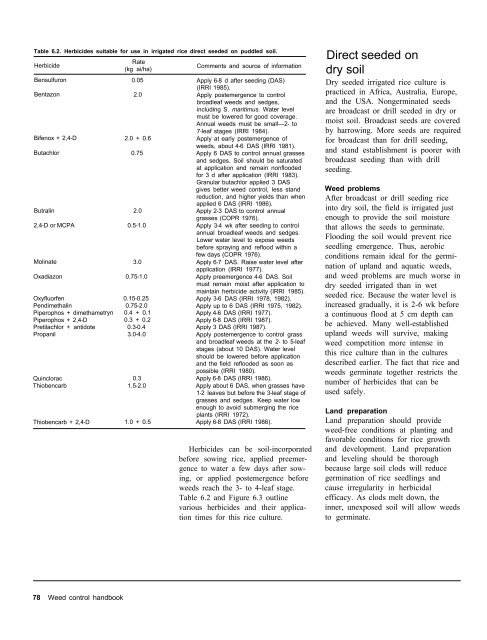A handbbok on Weed Control in Rice.pdf
A handbbok on Weed Control in Rice.pdf
A handbbok on Weed Control in Rice.pdf
You also want an ePaper? Increase the reach of your titles
YUMPU automatically turns print PDFs into web optimized ePapers that Google loves.
Table 6.2. Herbicides suitable for use <strong>in</strong> irrigated rice direct seeded <strong>on</strong> puddled soil.<br />
Herbicide<br />
Bensulfur<strong>on</strong><br />
Bentaz<strong>on</strong><br />
Bifenox + 2,4-D<br />
Butachlor<br />
Butral<strong>in</strong><br />
2,4-D or MCPA<br />
Mol<strong>in</strong>ate<br />
Oxadiaz<strong>on</strong><br />
Qu<strong>in</strong>clorac<br />
Thiobencarb<br />
Thiobencarb + 2,4-D<br />
Rate<br />
(kg ai/ha)<br />
0.05<br />
2.0<br />
2.0 + 0.6<br />
0.75<br />
2.0<br />
0.5-1.0<br />
3.0<br />
0.75-1.0<br />
Oxyfluorfen<br />
0.15-0.25<br />
Pendimethal<strong>in</strong><br />
0.75-2.0<br />
Piperophos + dimethame tryn 0.4 + 0.1<br />
Piperophos + 2,4-D<br />
0.3 + 0.2<br />
Pretilachlor + antidote<br />
0.3-0.4<br />
Propanil<br />
3.0-4.0<br />
78 <strong>Weed</strong> c<strong>on</strong>trol handbook<br />
0.3<br />
1.5-2.0<br />
1.0 + 0.5<br />
Comments and source of <strong>in</strong>formati<strong>on</strong><br />
Apply 6-8 d after seed<strong>in</strong>g (DAS)<br />
(IRRI 1985).<br />
Apply postemergence to c<strong>on</strong>trol<br />
broadleaf weeds and sedges,<br />
<strong>in</strong>clud<strong>in</strong>g S. maritimus. Water level<br />
must be lowered for good coverage.<br />
Annual weeds must be small—2- to<br />
7-leaf stages (IRRI 1984).<br />
Apply at early postemergence of<br />
weeds, about 4-6 DAS (IRRI 1981).<br />
Apply 6 DAS to c<strong>on</strong>trol annual grasses<br />
and sedges. Soil should be saturated<br />
at applicati<strong>on</strong> and rema<strong>in</strong> n<strong>on</strong>flooded<br />
for 3 d after applicati<strong>on</strong> (IRRI 1983).<br />
Granular butachlor applied 3 DAS<br />
gives better weed c<strong>on</strong>trol, less stand<br />
reducti<strong>on</strong>, and higher yields than when<br />
applied 6 DAS (IRRI 1986).<br />
Apply 2-3 DAS to c<strong>on</strong>trol annual<br />
grasses (COPR 1976).<br />
Apply 3-4 wk after seed<strong>in</strong>g to c<strong>on</strong>trol<br />
annual broadleaf weeds and sedges.<br />
Lower water level to expose weeds<br />
before spray<strong>in</strong>g and reflood with<strong>in</strong> a<br />
few days (COPR 1976).<br />
Apply 6-7 DAS. Raise water level after<br />
applicati<strong>on</strong> (IRRI 1977).<br />
Apply preemergence 4-6 DAS. Soil<br />
must rema<strong>in</strong> moist after applicati<strong>on</strong> to<br />
ma<strong>in</strong>ta<strong>in</strong> herbicide activity (IRRI 1985).<br />
Apply 3-6 DAS (IRRI 1978, 1982).<br />
Apply up to 6 DAS (IRRI 1975, 1982).<br />
Apply 4-6 DAS (IRRI 1977).<br />
Apply 6-8 DAS (IRRI 1987).<br />
Apply 3 DAS (IRRI 1987).<br />
Apply postemergence to c<strong>on</strong>trol grass<br />
and broadleaf weeds at the 2- to 5-leaf<br />
stages (about 10 DAS). Water level<br />
should be lowered before applicati<strong>on</strong><br />
and the field reflooded as so<strong>on</strong> as<br />
possible (IRRI 1980).<br />
Apply 6-8 DAS (IRRI 1986).<br />
Apply about 6 DAS, when grasses have<br />
1-2 leaves but before the 3-leaf stage of<br />
grasses and sedges. Keep water low<br />
enough to avoid submerg<strong>in</strong>g the rice<br />
plants (IRRI 1972).<br />
Apply 6-8 DAS (IRRI 1986).<br />
Herbicides can be soil-<strong>in</strong>corporated<br />
before sow<strong>in</strong>g rice, applied preemer-<br />
gence to water a few days after sow-<br />
<strong>in</strong>g, or applied postemergence before<br />
weeds reach the 3- to 4-leaf stage.<br />
Table 6.2 and Figure 6.3 outl<strong>in</strong>e<br />
various herbicides and their applica-<br />
ti<strong>on</strong> times for this rice culture.<br />
Direct seeded <strong>on</strong><br />
dry soil<br />
Dry seeded irrigated rice culture is<br />
practiced <strong>in</strong> Africa, Australia, Europe,<br />
and the USA. N<strong>on</strong>germ<strong>in</strong>ated seeds<br />
are broadcast or drill seeded <strong>in</strong> dry or<br />
moist soil. Broadcast seeds are covered<br />
by harrow<strong>in</strong>g. More seeds are required<br />
for broadcast than for drill seed<strong>in</strong>g,<br />
and stand establishment is poorer with<br />
broadcast seed<strong>in</strong>g than with drill<br />
seed<strong>in</strong>g.<br />
<strong>Weed</strong> problems<br />
After broadcast or drill seed<strong>in</strong>g rice<br />
<strong>in</strong>to dry soil, the field is irrigated just<br />
enough to provide the soil moisture<br />
that allows the seeds to germ<strong>in</strong>ate.<br />
Flood<strong>in</strong>g the soil would prevent rice<br />
seedl<strong>in</strong>g emergence. Thus, aerobic<br />
c<strong>on</strong>diti<strong>on</strong>s rema<strong>in</strong> ideal for the germi-<br />
nati<strong>on</strong> of upland and aquatic weeds,<br />
and weed problems are much worse <strong>in</strong><br />
dry seeded irrigated than <strong>in</strong> wet<br />
seeded rice. Because the water level is<br />
<strong>in</strong>creased gradually, it is 2-6 wk before<br />
a c<strong>on</strong>t<strong>in</strong>uous flood at 5 cm depth can<br />
be achieved. Many well-established<br />
upland weeds will survive, mak<strong>in</strong>g<br />
weed competiti<strong>on</strong> more <strong>in</strong>tense <strong>in</strong><br />
this rice culture than <strong>in</strong> the cultures<br />
described earlier. The fact that rice and<br />
weeds germ<strong>in</strong>ate together restricts the<br />
number of herbicides that can be<br />
used safely.<br />
Land preparati<strong>on</strong><br />
Land preparati<strong>on</strong> should provide<br />
weed-free c<strong>on</strong>diti<strong>on</strong>s at plant<strong>in</strong>g and<br />
favorable c<strong>on</strong>diti<strong>on</strong>s for rice growth<br />
and development. Land preparati<strong>on</strong><br />
and level<strong>in</strong>g should be thorough<br />
because large soil clods will reduce<br />
germ<strong>in</strong>ati<strong>on</strong> of rice seedl<strong>in</strong>gs and<br />
cause irregularity <strong>in</strong> herbicidal<br />
efficacy. As clods melt down, the<br />
<strong>in</strong>ner, unexposed soil will allow weeds<br />
to germ<strong>in</strong>ate.











